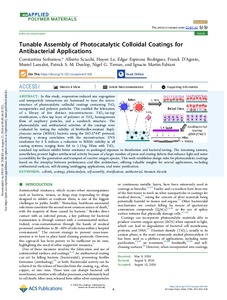Tunable Assembly of Photocatalytic Colloidal Coatings for Antibacterial Applications
Sofroniou, Constantina; Scacchi, Alberto; Le, Huyen; Espinosa Rodriguez, Edgar; D’Agosto, Franck; Lansalot, Muriel; Dunlop, Patrick S. M.; Ternan, Nigel G.; Martín-Fabiani, Ignacio
Tunable Assembly of Photocatalytic Colloidal Coatings for Antibacterial Applications
Sofroniou, Constantina
Scacchi, Alberto
Le, Huyen
Espinosa Rodriguez, Edgar
D’Agosto, Franck
Lansalot, Muriel
Dunlop, Patrick S. M.
Ternan, Nigel G.
Martín-Fabiani, Ignacio
American Chemical Society
Julkaisun pysyvä osoite on:
https://urn.fi/URN:NBN:fi-fe2025082791944
https://urn.fi/URN:NBN:fi-fe2025082791944
Tiivistelmä
In this study, evaporation-induced size segregation and interparticle interactions are harnessed to tune the microstructure of photocatalytic colloidal coatings containing TiO2 nanoparticles and polymer particles. This enabled the fabrication of a library of five distinct microstructures: TiO2-on-top stratification, a thin top layer of polymer or TiO2, homogeneous films of raspberry particles, and a sandwich structure. The photocatalytic and antibacterial activities of the coatings were evaluated by testing the viability of Methicillin-resistant Staphylococcus aureus (MRSA) bacteria using the ISO-27447 protocol, showing a strong correlation with the microstructure. UVA irradiation for 4 h induces a reduction in MRSA viability in all coating systems, ranging from 0.6 to 1.1 log. Films with TiO2-enriched top surfaces exhibit better resistance to prolonged exposure to disinfection and bacterial testing. The remaining systems, nonetheless, present higher antibacterial activity because of a larger number of pores and coating defects that enhance light and water accessibility for the generation and transport of reactive oxygen species. This work establishes design rules for photocatalytic coatings based on the interplay between performance and film architecture, offering valuable insights for several applications, including antibacterial surfaces, self-cleaning/antifogging applications, and water purification.
Kokoelmat
- Rinnakkaistallenteet [27094]
